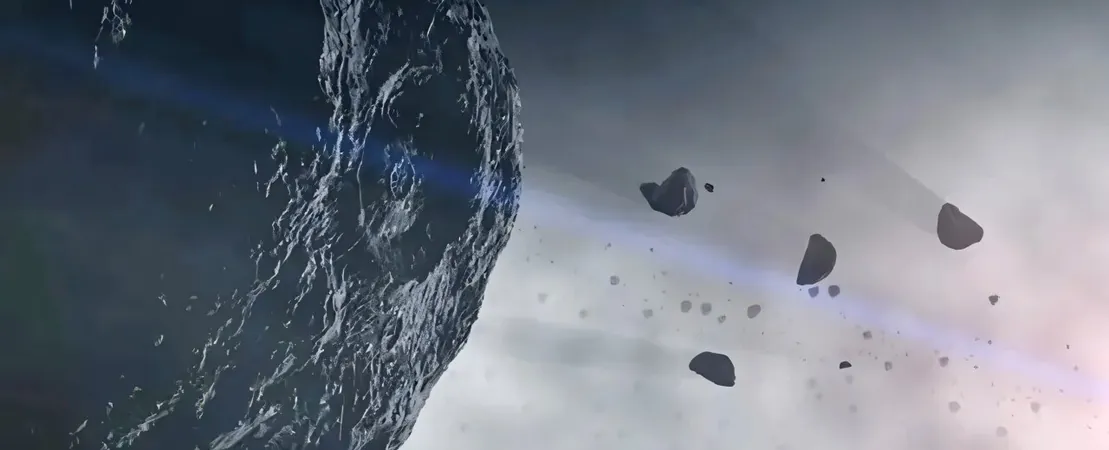
Could Asteroids Become Astronaut Lifesavers on the Journey to Mars?
2024-12-05
Author: Amelia
Introduction
As humanity strides closer to its ambitious goal of colonizing Mars, one of the most pressing threats during long-duration space missions is radiation exposure. With top organizations like NASA and SpaceX gearing up for extensive journeys to the Red Planet, the challenge of protecting astronauts from harmful cosmic rays is more critical than ever. Traditional shielding methods, which involve heavy materials, pose both weight and cost challenges when launched into space.
The Concept of Using Asteroids for Shielding
But what if astronauts could harness a natural cosmic shield instead? A groundbreaking study by Victor Reshetnyk and his team at Kyiv's Taras Shevchenko National University suggests that NASA's treasure trove of near-Earth asteroids might hold the key. According to their findings, shielding astronauts with massive asteroids already in space could significantly reduce the risks associated with radiation exposure.
Study Findings
The study meticulously examined data from NASA's Horizons service, which included trajectories of over 35,000 Near Earth Objects (NEOs). The researchers aimed to find paths that would intersect between critical planetary hubs, such as Earth, Venus, and Mars. To their delight, they discovered viable options—an estimated 525 asteroids capable of completing "fast" transfers taking less than 180 days.
Identification of Promising Asteroids
After refining their search to ensure these trajectories would be realistically accessible to crewed spacecraft, the researchers narrowed the list to 120 promising candidates. The breakdown of these potential asteroids was as follows: - Earth to Venus: 44 - Earth to Mars: 17 - Mars to Earth: 13 - Mars to Venus: 2 - Venus to Earth: 38 - Venus to Mars: 6
Limitations and Potential
While the prospects of hitching a ride on these cosmic giants seem exciting, the largest identified asteroid is only about 0.37 kilometers in diameter—modest compared to traditional spacecraft. Nonetheless, there's still sufficient space to accommodate a smaller vessel.
Multi-Transfer Potential
What’s even more intriguing is that some asteroids could function as multi-transfer checkpoints. For instance, eleven asteroids hinted at the potential for traveling between planets multiple times, with one even capable of making a "double" transfer from Earth to Mars within a year. However, the authors did not identify any “Aldrin Cyclers” among the candidates—asteroids that could indefinitely shuttle between planetary systems in a predictable orbit.
Future Exploration Plans
Despite the apparent limitations of current findings, it's worth noting that our understanding of near-Earth asteroids is still evolving. Upcoming missions like NASA’s NEO Surveyor, set to launch in 2028, aim to identify 90% of all near-Earth objects larger than 140 meters. This could exponentially increase our knowledge of these celestial wonders and potentially highlight more candidates for safe passage in the cosmos.
Conclusion
As the exploration of asteroids progresses, humanity may find its next step toward Mars not just within a spacecraft but aboard a natural shield floating through space. Who knew that our cosmic neighbors might save us from the very perils of deep space exploration?



 Brasil (PT)
Brasil (PT)
 Canada (EN)
Canada (EN)
 Chile (ES)
Chile (ES)
 Česko (CS)
Česko (CS)
 대한민국 (KO)
대한민국 (KO)
 España (ES)
España (ES)
 France (FR)
France (FR)
 Hong Kong (EN)
Hong Kong (EN)
 Italia (IT)
Italia (IT)
 日本 (JA)
日本 (JA)
 Magyarország (HU)
Magyarország (HU)
 Norge (NO)
Norge (NO)
 Polska (PL)
Polska (PL)
 Schweiz (DE)
Schweiz (DE)
 Singapore (EN)
Singapore (EN)
 Sverige (SV)
Sverige (SV)
 Suomi (FI)
Suomi (FI)
 Türkiye (TR)
Türkiye (TR)
 الإمارات العربية المتحدة (AR)
الإمارات العربية المتحدة (AR)